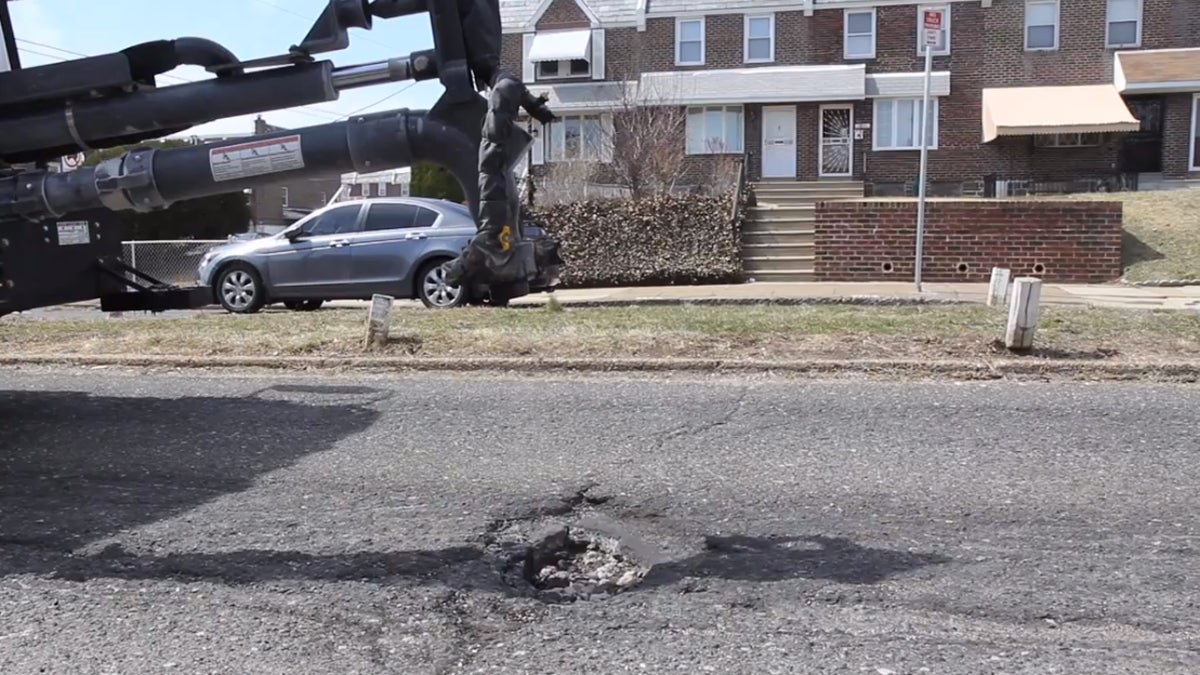The science behind fixing Philadelphia’s $550,000 pothole problem
Listen
Philadelphia's 'pothole killer' machine uses its extended arm to work its way back and forth
The streets are lurking with a dangerous science experiment that’s been brewing underground for months.
Potholes are a worst nightmare for drivers and bikers. This year, Philadelphia has more than ever.
The proof lies on roadways across the region. In just about every Philly neighborhood, drivers have had enough.
Society Hill resident Kristina Dechter recently moved here from Los Angeles, where she says potholes don’t plague the streets. She said her “California Prius” is struggling to deal with the city’s pock-marked roads.
In Philly, she confronts them close to home.
“There’s a pothole on 4th St. and Lombard, that’s actually two potholes catty-corner to each other.”
Dechter says it’s nearly impossible to avoid getting a tire jammed in that one. She says she’s even changed her route to avoid a particularly bad stretch of potholes.
The ‘perfect storm’ for pothole creation
Those complaints are not news to researcher Leslie McCarthy.
“People love to ask about the potholes and I’ve heard that from family members, from strangers that I meet and that’s why I think transportation and pavement engineering, in particular, is so exciting,” says McCarthy.
McCarthy’s an Assistant Professor of Civil and Environmental Engineering at Villanova University. She says this year’s been a perfect storm for pothole creation.
Remember those warm-ish days we had, that were sandwiched in between all that freezing, snowy weather? While Philadelphians enjoyed a nice long bike ride in the moderate temperatures, McCarthy says inside the pavement beneath them, craters were being born.
“Potholes are one of the tough cookies in terms of pavement damage and the reason is it’s purely what we call an ‘environmental loading’ phenomenon. So you have a series of freeze and thaw cycles that will cause these potholes to occur. And potholes are going to occur anywhere where there’s an existing crack.”
McCarthy says water slides in through those cracks and joints, and as temperatures plummet, it turns to ice. That takes up more space than liquid water: So the ice pushes out the pavement and breaks it.
She says to repair the roadway, the pavement and the hole are heated up and a toasty “hot mix” — that’s hotter than 300 degrees Fahrenheit — is poured in.
It takes work to fill the road gaps Mother Nature has created.
The ‘pothole killer’ approach
Standing in front of two-story brick-front houses in Juniata Park, the Streets Department’s Chief Highway Engineer Steve Lorenz watches a machine at work.
“What we have is our pothole patcher or sometimes called pothole killer machine,” he says. “It’s a machine that the city of Philadelphia uses to fill potholes in a mechanical type manner.”
Lorenz explains the pothole-filling method, while the extended arm of the pothole filler works its way back and forth, shooting a spray into a pothole.
“It’ll spray air into the hole to clean out any loose debris or water, it’ll then spray an emulsion into the hole. That’ll allow the stone and the aggregate to stick to the hole. Then it’ll spray some stone in and within the stone it’ll also have some of that emulsion fluid in there – to stick it all together.”
Lorenz explains that after the hole is filled, the truck and then regular traffic drives over it – packing down the stones and emulsion, which is a thin tar-like substance that allows the gravel to bond together and to the side and bottom of the pothole.
Fixing a $550,000 problem
This winter’s been a beast for the Philadelphia area. The city expects to break a record this year with the number of potholes fixed: It’s already topped 25,000, at a cost of about $22 each. That’s a hefty $550,000 price tag to fix the holes.
To prevent potholes from springing up, Villanova engineer Leslie McCarthy says road crews can seal up cracks in the road and provide good drainage when building roads.
McCarthy says there are also national and state studies being done to look at new technology and how to prevent moisture damage — which is ultimately what causes the potholes.
“One method is to add fibers or other types of additives. That’s going to increase the tensile strength. Meaning, the cracks aren’t going to develop as easily and therefore the water isn’t going to get in as easily.”
McCarthy passes a bunch of those “high tensile strength synthetic fibers” across the table. The yellow pieces look like a doll’s hair. McCarthy says new equipment is also being studied – for example a tow-behind mobile system that uses infra-red technology to heat up the pothole, and then fill it with a hot patch. She says that sort of mobile system is faster and safer than crews manually doing the work.
“We have a saying in highway construction: ‘Get in, get out, stay out.’ So this type of unit would help towards that end.”
Technology’s not the only thing that’ll help improve the roads: money helps too.
Gene Blaum is a spokesman for the Pennsylvania Department of Transportation.
“The pavement damage that’s occurred during this winter season, as we head into the Spring, is as severe as we’ve had in this region at least in the past 20 to 30 years.”
Blaum says thanks to the recent passage of the new Transportation Funding Bill, PennDOT will be resurfacing more roads and fixing more bridges.
He points out that it’s worth it for motorists and others who see potholes to report them. He says the sooner the pothole is reported, the faster it can get repaired.
WHYY is your source for fact-based, in-depth journalism and information. As a nonprofit organization, we rely on financial support from readers like you. Please give today.



